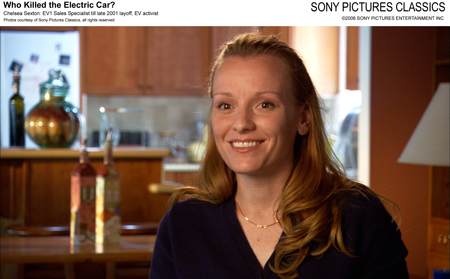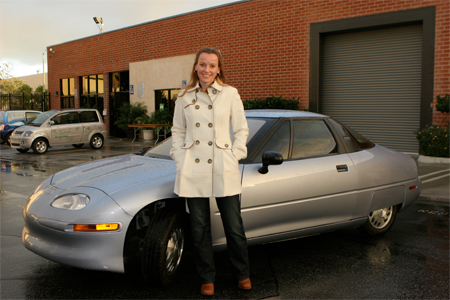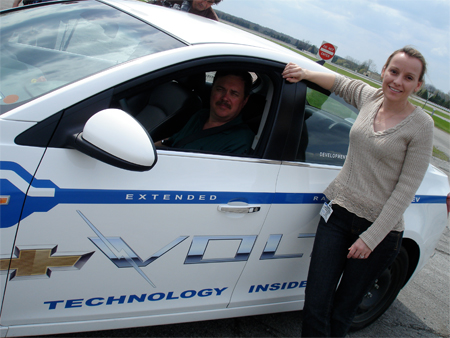Electric cars, undergoing a renaissance today, did not always find themselves in such wonderful times. Who Killed the Electric Car?, a 2006 documentary which explored early, and unfortunately failed, brought to light underwhelming attempts to make electric cars available to the public in the 1990s. One person who rose from the ashes of this though to continue the EV fight was Chelsea Sexton. Sexton, according to Wikipedia, got involved with General Motors’ failed EV1 electric car program early on. She was unfortunately laid off from GM when the program was shutdown in 2001, but since then has been a tireless advocate of alternative fuel – most specifically electric – vehicles. She has been involved with Plug In America and now serves as the founder of the Lightning Rod Foundation.
We caught up with Sexton over email just prior to Thanksgiving to get her thoughts on the status of electric vehicle acceptance in the United States today and whether or not consumers and car makers are ready to welcome these cars into mainstream society.
EarthTechling: Tell us a little bit about your background in the electric vehicle world. How did you come to get involved in it?
Chelsea Sexton: Unexpectedly! When I was 17, I started working for General Motors (Saturn)- I was insistent on paying my own way through college and liked what the company stood for. A few years later, GM announced the EV1; I was intrigued enough to move over to that project where I found my inner geek. Ok, it may have had something to do with that first test drive and the torque of an AC motor- I was definitely smitten!
ET: Many people know you from the documentary Who Killed the Electric Car? Did you ever expect your presence in that film would elevate you to being such a spokesperson for electric vehicles today?

Sexton: Not a chance! For one thing, I’m incredibly shy by nature and was never supposed to be in the film- it remains a joke among the crew that when we did the main interview, they assured me they’d only use about two seconds of it because I was so nervous. Of course, we didn’t know if the film would ever end up in theaters anyway- we thought we’d end up burning copies for our parents and moving on with our lives. So seeing it premiere at Sundance was a bit of a shock, and it’s been an adventure ever since. But much as it still feels strange to be the one on the stage instead of behind the curtain, I’m grateful to have had the opportunity to help bring electric vehicles back after a lot of dark years. And we’ve been thrilled to see how much the film has been embraced by the public..so much so that we’re working on another one, called “Revenge of the Electric Car”.
ET: Explain, in your own words, the differences you see between regular hybrids like the Prius and plug-in hybrids/electric vehicles. Do you feel the Prius is just a temporary evolutionary step in consumers adopting in mass mainstream amounts vehicles which are more eco-friendly, or will electric vehicles eventually pass up regular hybrids in sales?
Sexton: The currently-available hybrids like the Prius are still gasoline vehicles at the end of the day, and they’ve been a double-edged sword. They certainly deserve credit for getting people to embrace efficient driving, and for those who never had the chance to experience an EV, they’ve helped to get folks used to the idea of electricity in vehicles. The flip side is that they’ve also helped to foster complacency; for several years, consumers (and several car companies) thought that hybrids were enough and there’s no reason to do better. We lost a lot of momentum in those years that we’re only now starting to get back.
That said, hybrids can can be made even better with the addition of a plug. One of Plug In America’s founders, Marc Geller, has been known to say that the best way to get people to use less oil is to give them the opportunity to use none, and he’s right. Electricity is cleaner (even with our current national grid) and cheaper than gasoline, and it’s domestically-produced. They key is that there’s room in the market for several types of electrified vehicles, whether a plug-in hybrid (PHEV) like the new Ford Escape in SCE’s test fleet that drives electrically up to a certain speed, an extended-range electric vehicle (EREV) like the Chevy Volt that drives in all electric mode for a given number of miles, or a battery electric vehicle (EV) like the Nissan Leaf that doesn’t use a liquid fuel at all. The cool thing for the consumer is that there are several of each type coming to market over the next few years in all sorts of shapes and sizes- but that doesn’t mean that there won’t be a place for hybrids and even efficient gasoline and diesel vehicles for years to come.
Unfortunately, companies like Toyota and Honda used their gasoline-hybrid advertising campaigns over the last decade to denigrate EVs of all stripes with tag lines like “you don’t have to plug it in”, as if that were a downside instead of the convenience and economic benefit EV drivers know it to be. So in addition to the new technology education we need to do as plug-ins get ready to come to market, we also have to undo a fair amount of damage done by some of the very car companies planning to make these cars.
ET: When consumers consider electric vehicles for purchase today, what EV limitations do you think hamper people from making a purchase? How do you feel these limitations can be overcome so EVs gain greater acceptance?
Sexton: At this point, the biggest hindrance to EV adoption is lack of available vehicles, pure and simple. It’s the number one complaint I hear from the public. After that, we tend to hear a lot about affordability and range anxiety. Of course, we want to get the price of batteries (and therefore vehicles) down, but we do have enough pent-up demand by early adopters to consume the first few years of production even at current pricing- so that’s not yet a hindrance. We’d like to reduce costs before it becomes a significant issue, but leasing (of either batteries or vehicles) and other models can also help make these cars more affordable.
Range-anxiety is where we’ve really gotten in the weeds lately. Sure, there’s an initial concern about getting stranded in a pure EV- but our experience is that it falls away as people figure out pretty quickly that they don’t drive nearly as far as they thought, and that because of home charging, most of them wake up every morning with a full “tank”- something that rarely happens in a gas vehicle. Infrastructure helps too, but we found in the last EV generation that a sprinkling of “basic” 240-volt chargers in the right places was far more effective and far less costly than trying to blanket an area. We can always layer on more or faster chargers as we see where plug-ins pool geographically, but we learned firsthand that drivers were less concerned with being able to refuel in minutes on every street corner, and more just liked knowing it was out there if they needed it. And those who really do drive long distances occasionally or like the idea of a gasoline “safety net” can still be perfectly happy with a PHEV or EREV, both of which can use public charging but aren’t dependent on it.
So all of this boils down to the biggest limitation being the lack of consumer and market understanding by automakers and other stakeholders, which has led to choices being made on the consumers’ behalf about what they want and will therefore be able to have. Not only is this arrogant, it’s counter-productive, especially given that there’s a pool of resident experience in the veterans who were part of the last EV programs and a built-in focus group of current and former EV drivers to learn from. Sure, some things have changed and there’s going to be plenty more to learn- which is all the more reason not to waste time and resources re-learning the same lessons we covered years ago.

ET: We’ve written a lot about different EV start ups unveiling a wide array of potential cars of the future. Do you have any particular ones in mind you think have a greater chance of success and why?
Sexton: The start-up arena is a challenging one- just about every day I get an inquiry along the lines of “why wait for one of the big car companies, can’t we all just band together and start a car company ourselves?” I love the spirit, but the barriers to entry are huge- and as we’ve seen time and time again, having a good idea- and even some funding- is not necessarily enough. Really promising start-up companies- Tesla, Th!nk, and others, have had struggles and mis-steps. Some have learned and recovered, and others are still struggling or have faded away.
Of the current start-ups, Tesla Motors is still the obvious leader. With approximately 1,000 Roadsters delivered, they’ve already put more EVs on the road than many of the major car companies ever have. They’ve already gotten thousands of deposits on their next vehicle, the Model S, due out in 2012- and thanks to a $465 million DOE loan, they have the funding to build it. And they became profitable earlier this year, something even several of the larger companies are struggling with. But it’s Tesla’s relationship with Daimler that’s the most promising. Tesla already has an agreement in place to supply battery packs for the smart ED, but that could be just the beginning. Frankly, I think we’ll see more of these types of partnerships between large automakers and start-ups – the smart ones at least.
While not yet significantly funded, I’m also a fan of Bright Automotive- they have one of the best teams I’ve ever seen in a small company; instead of falling into the common start-up trap of shunning anyone from the auto industry, they’ve assembled a group with deep engineering and production experience tempered with a spirit to innovate. Their vehicle- the IDEA, is a fleet van- not as attention-getting as a sports car, but huge potential to off-set petroleum use in lots and lots of daily driving. And in an industry known for ego, they’re refreshingly humble- which just makes me want to root for them more.
We may also see some significant competition from companies like BYD in China. If they can meet expectations for quality and safety at a lower cost, there’s a definite opportunity to capture a chunk of the US EV market.
The encouraging thing for all of the start-ups, however, is that the rules have changed a little bit. Not too long ago, a press release from a large car company was considered enough to substantiate a program, while a small company was “vaporware” ‘til proven otherwise. Now, there’s abundant cynicism about the majors while smaller companies are being backed by incredibly prominent investors and VC firms and starting to deliver product- so the definition of who’s “legitimate” is changing. Regardless of size, however, all companies will have to prove themselves. Especially among the veterans of the EV industry, the litmus test is becoming, “until I can see it, touch it and preferably drive it, it’s not real”, whether the company in question is Ford or Fisker. And General Motors is setting a new bar of expected transparency with the Volt program that the others will have to try to meet. Given the history, it’s no longer acceptable to operate under a veil of secrecy and expect instant support when the vehicle launches.
ET: What is the ideal electric vehicle in your opinion?

Sexton: The ideal electric vehicle is one people can and will put in their driveways, whether that’s a PHEV, EREV, or EV, and in the form of a car, truck, or SUV. Just as there’s no one gas car that’s “the car for everyone”, there’s no ideal plug-in in my book. I fully expect we’ll see some winners and losers, but within reason, that’s for the market to sort.
ET: On more of a personal note, what car do you currently drive? What EV do you have your eye on if you could purchase any particular one on the market or coming to market soon?
Sexton: I actually still drive the same little Saturn I’ve had for years. My plan is not to buy another car of any kind ‘til I can get something with a plug on it. Personally, I want something with at least some pure EV range- I’ve driven both the Volt and the Leaf, and was impressed. The Mitsubishi iMiev is a neat little car too, but I’m not sure I’m patient enough to wait for one! The EV1 totally spoiled me in terms of performance, so I adore the Tesla Roadster, but it’s a bit out of my price range. Luckily, my husband works there, so every once in a while I get a ride!